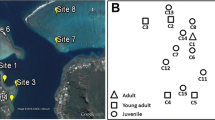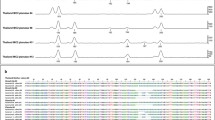Abstract
Aspects of maternal-planula larval genetics in the monoecious scleractinian coral Stylophora pistillata (Red Sea, Eilat) were studied by amplified fragment length polymorphism (AFLP) methodology in two successive reproductive seasons. In total, 293 planulae and 10 adult colonies were analyzed. In June 2006, 147 planulae were collected from 10 shallow water colonies. In March, April and June 2007, 146 additional planulae were sampled from five of the ten 2006 sampled colonies. All AFLP products showed unalike band profiles indicating a fully sexual production pattern. We used 181 and 210 putative AFLP loci, of which the overall level of polymorphism in 2006 was 92 and 99 % in 2007 (respectively). Differences were also observed between 2006 and 2007 reproductive seasons in terms of total average gene diversity (0.191 vs. 0.247, respectively), suggesting fast turnover of sperm donor genotypes. In addition, increased numbers of potential sperm donor colonies in the vicinity of gravid females showed no impact on genetic differentiation levels in released larvae. UPGMA tree revealed clustering of maternal genotypes and their offspring, suggesting, as expected, high relatedness between planulae and their mothers. In addition, the average heterozygosity of each group of siblings was persistently lower than heterozygosity calculated for the respective maternal colony, suggesting the possibility of partial inbreeding. This trend of reduced genetic heterogeneity in Stylophora pistillata is an alarming sign for populations residing in the northern Red Sea coral reefs.



Similar content being viewed by others
References
Amar KO, Rinkevich B (2007) A floating mid-water coral nursery as larval dispersion hub: testing an idea. Mar Biol 151:713–718
Amar KO, Rinkevich B (2010) Mounting of erratic histoincompatible responses in hermatypic corals: a multi-years interval comparison. J Exp Biol 213:535–540
Amar KO, Chadwick NE, Rinkevich B (2007) Coral planulae as dispersion vehicles: biological properties of larvae released early and late in the season. Mar Ecol Prog Ser 350:71–78
Amar KO, Chadwick NE, Rinkevich B (2008a) Coral kin aggregations exhibit mixed allogeneic reactions and enhanced fitness during early ontogeny. BMC Evol Biol 8:126
Amar KO, Douek J, Rabinowitz C, Rinkevich B (2008b) Employing of the amplified fragment length polymorphism (AFLP) methodology as an efficient population genetic tool for symbiotic cnidarians. Mar Biotechnol 10:350–357
Atoda K (1947) The larva and post-larval development of the reef-building corals. II. Stylophora pistillata. Rep Tohoku Univ 4th Ser 18:49–61
Ayre DJ, Hughes TP (2000) Genotypic diversity and gene flow in brooding and spawning corals along the Great Barrier Reef, Australia. Evolution 54:1590–1605
Ayre DJ, Miller KJ (2004) Where do clonal coral larvae go? Adult genotypic diversity conflicts with reproductive effort in the brooding coral Pocillopora damicornis. Mar Ecol Prog Ser 277:95–105
Ayre DJ, Resing JM (1986) Sexual and asexual production of planulae in reef corals. Mar Biol 90:187–190
Ayre DJ, Hughes TP, Standish RJ (1997) Genetic differentiation, reproductive mode, and gene flow in the brooding coral Pocillopora damicornis along the Great Barrier Reef, Australia. Mar Ecol Prog Ser 159:175–187
Barki Y, Douek J, Graur D, Gateño D, Rinkevich B (2000) Polymorphism in soft coral larvae revealed by amplified fragment-length polymorphism (AFLP) markers. Mar Biol 136:37–41
Bensch S, Akesson M (2005) Ten years of AFLP in ecology and evolution: why so few animals? Mol Biol 14:2899–2914
Bonin A, Ehrich D, Manel S (2007) Statistical analysis of amplified fragment length polymorphism data: a toolbox for molecular ecologists and evolutionists. Mol Ecol 16:3737–3758
Corander J, Marttinen P, Sirén J, Tang J (2008) Enhanced Bayesian modelling in BAPS software for learning genetic structures of populations. BMC Bioinform 9:539
Dasmahapatra KK, Lacy RC, Amos W (2008) Estimating levels of inbreeding using AFLP markers. Heredity 100:286–295
Fadlallah YH (1983) Sexual reproduction, development and larval biology in scleractinian corals. Coral Reefs 2:129–150
Fautin DG (2002) Reproduction of Cnidaria. Can J Zool 80:1735–1754
Frank U, Oren U, Loya Y, Rinkevich B (1997) Alloimmune maturation in the coral Stylophora pistillata is achieved through three distinctive stages, 4 months post metamorphosis. Proc R Soc Lond B 264:99–104
Fuchs Y, Douek J, Rinkevich B, Ben-shlomo R (2006) Gene diversity and mode of reproduction in the brooded larvae of the coral Heteroxenia. J Hered 97:493–498
Goldstein DB, Pollock DD (1997) Launching microsatellites: a review of mutation processes and methods of phylogenetic inference. J Hered 88:335–342
Graham DE (1978) The isolation of high molecular weight DNA from whole organisms or large tissue masses. Anal Biochem 85:609–613
Harrison PL, Wallace CC (1990) Reproduction, dispersal and recruitment of scleractinian corals. In: Dubinsky Z (ed) Ecosystems of the world: coral reefs. Elsevier Science, Amsterdam, pp 133–207
Harrison PL, Babcock RC, Bull GD, Oliver JK, Wallace CC, Willis BL (1984) Mass spawning in tropical reef corals. Science 223:1186–1189
Jarne P, Charlesworth D (1993) The evolution of the selfing rate in functionally hermaphrodite plants and animals. Annu Rev Ecol Syst 24:441–466
Johnson SL, Yund PO (2009) Effects of fertilization distance on male gain curves in a free-spawning marine invertebrate: a combined empirical and theoretical approach. Evolution 63:3114–3123
Ladah L, Bermudez R, Pearson G, Serrão E (2003) Fertilization success and recruitment of dioecious and hermaphroditic fucoid seaweeds with contrasting distributions near their southern limit. Mar Ecol Prog Ser 262:173–183
Linden B, Rinkevich B (2011) Creating stocks of young colonies from brooding-coral larvae, amenable to active reef restoration. J Exp Mar Biol Ecol 398:40–46
Loya Y (1976) Settlement, mortality and recruitment of a Red Sea scleractinian coral population. In: Mackie G (ed) Coelenterate Ecology and Behaviour. Plenum Press, New York, pp 89–100
Marquez LM, MacKenzie JB, Takabayashi M, Smith CR, Cehn CA (2003) Difficulties in obtaining microsatellites from acroporid corals. Proc 9th Int Coral Reef Symp 1:139–143
McCartney MA (1997) Sex allocation and male fitness gain in a colonial, hermaphroditic marine invertebrate. Evolution 51:127–140
Miller MP (1997) Tools for population genetic analyses (TFPGA) version 1.3. Department of Biological Sciences, Northern Arizona University. Flagstaff, AZ
Miller KJ, Ayre DJ (2004) The role of sexual and asexual reproduction in structuring high latitude populations of the reef coral Pocillopora damicornis. Heredity 92:557–568
Nei M (1978) Estimation of average heterozygosity and genetic distance from a small number of individuals. Genetics 89:583–590
Nei M (1987) Molecular evolutionary genetics. Columbia University Press, New York
Nishikawa A, Sakai K (2005) Settlement-competency period of planulae and genetic differentiation of the scleractinian coral Acropora digitifera. Zool Sci 22:391–399
Nishikawa A, Katoh M, Sakai K (2003) Larval settlement rates and gene flow of broadcast spawning (Acropora tenuis) and planula-brooding (Stylophora pistillata) corals. Mar Ecol Prog Ser 256:87–97
Oliver J, Babcock R (1992) Aspects of the fertilization ecology of broadcast spawning corals: Sperm dilution effects and in situ measurements of fertilization. Biol Bull 183:409–417
Peakall R, Smouse PE (2006) GENALEX 6: genetic analysis in Excel. Population genetic software for teaching and research. Mol Ecol Notes 6:288–295
Raymond ML, Rousset F (1995) An exact test for population differentiation. Evolution 49:1280–1283
Richmond RH, Hunter CL (1990) Reproduction and recruitment of corals: comparisons among the Caribbean, the tropical Pacific, and the Red Sea. Mar Ecol Prog Ser 60:185–203
Ridgway T, Gates R (2006) Why are there so few genetic markers available for coral population analyses? Symbiosis 41:1–7
Rinehart TA (2004) AFLP analysis using GeneMapper® software and an Excel® macro that aligns and converts output to binary. United States Department of Agriculture, Poplarville, MS, USA. Biotechniques 37:186–188
Rinkevich B, Loya Y (1979a) The reproduction of the Red Sea coral Stylophora pistillata. Mar Ecol Prog Ser 1:133–144
Rinkevich B, Loya Y (1979b) The reproduction of the Red Sea coral Stylophora pistillata. II. Synchronization in breeding and seasonality of planulae shedding. Mar Ecol Prog Ser 1:45–152
Rinkevich B, Loya Y (1986) Senescence and dying signals in a reef building coral. Experientia 42:320–322
Rinkevich B, Loya Y (1987) Variability in the pattern of sexual reproduction of the coral Stylophora pistillata at Eilat, Red Sea: a long-term study. Biol Bull (Woods Hole) 173:335–344
Sherman CDH (2008) Mating system variation in the hermaphroditic brooding coral, Seriatopora hystrix. Heredity 100:96–303
Shlesinger Y, Loya Y (1985) Coral community reproductive patterns: Red sea versus the Great Barrier Reef. Science 228:1333–1335
Stoddart JA (1983) The asexual production of planulae in the coral Pocillopora damicornis. Mar Biol 76:279–284
Takabayashi M, Carter DA, Lopez JV, Hoegh-Guldberg O (2003) Genetic variation of the scleractinian coral Stylophora pistillata, from western Pacific reefs. Coral Reefs 22:17–34
Toonen RJ, Pawlik JR (2001) Foundations of gregariousness: a dispersal polymorphism among the planktonic larvae of a marine invertebrate. Evolution 55:2439–2454
van Oppen MJH, Lutz A, De’ath G, Peplow L, Kininmonth S (2008) Genetic traces of recent long-distance dispersal in a predominantly self-recruiting coral. PLoS ONE 3:e3401
Vermeij MJA, Sampayo E, Broker K, Bak RPM (2003) Variation in planulae release of closely related coral species. Mar Ecol Prog Ser 247:75–84
Vollmer SV, Palumbi SR (2004) Testing the utility of internally transcribed spacer sequences in coral phylogenetics. Mol Ecol 13:2763–2772
Vos P, Hogers R, Bleeker M, Reijans M, van de Lee T, Hornes M, Frijters A, Pot J, Peleman J, Kuiper M, Zabeau M (1995) AFLP: a new technique for DNA fingerprinting. Nucleic Acids Res 23:4407–4414
Yeh C, Yang C, Boyle T (1999) Popgene Version 1.31 Canada: University of Alberta
Yund PO, O’Neil PG (2000) Microgeographic genetic differentiation in a colonial ascidian (Botryllus schlosseri) population. Mar Biol 137:583–588
Zakai D, Dubinsky Z, Avishai A, Caaras T, Chadwick NE (2006) Lunar periodicity of planula release in the reef-building coral Stylophora pistillata. Mar Ecol Prog Ser 311:93–102
Acknowledgement
We acknowledge the assistance of E. Reem, R. Ben-Shlomo and S. Avrani in the analyses and the IUI staff for using their facility. This study was supported by the INCO-DEV project (REEFRES, No. 510657), CORALZOO, an EC Collective Research project (No. 012547) and the AID-CDR program (No. C23-004). This research has fulfilled part of the requirements for the doctoral degree by K. O. Amar at Bar-Ilan University.
Author information
Authors and Affiliations
Corresponding author
Additional information
Jacob Douek and Keren-Or Amar have contributed equally to this work.
Rights and permissions
About this article
Cite this article
Douek, J., Amar, KO. & Rinkevich, B. Maternal-larval population genetic traits in Stylophora pistillata, a hermaphroditic brooding coral species. Genetica 139, 1531–1542 (2011). https://doi.org/10.1007/s10709-012-9653-x
Received:
Accepted:
Published:
Issue Date:
DOI: https://doi.org/10.1007/s10709-012-9653-x




